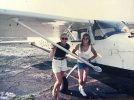Looks like LAX99LA190, May 22, 1999.
Federal Aviation Administration (FAA) inspectors interviewed a number of witnesses who either observed the sequence of events or had knowledge of the flight. Several of the witnesses said that the pilot's practice, especially with high altitude jumps, was to land before the jumpers had reached the ground. The witnesses first observed the airplane, as it appeared to be maneuvering toward runway 26 for landing; the location of the airplane and its maneuvers were similar to other approaches made by the pilot that day. The only unusual aspect reported by the witnesses was that the airplane's altitude above the water was lower than on previous flights. Some witnesses estimated the height above water as 200 feet. The airplane was in a turn toward the southwest when the nose dropped and it flew into the water.
Some witnesses described the bank angle as steep, while others reported it as normal. The witnesses who observed the airplane descend into the ocean recalled hearing the engines, and stated that there had been a high-pitched sound, but that the engines were not sputtering or popping. They also stated that the airplane did not look out of control, but rather that it was in a steady descent, with no erratic movements evident.
An FAA inspector reported that this was the 11th flight of the day. The inspector interviewed two of the skydivers who jumped from the accident airplane, on previous flights, and on the accident flight. Both skydivers stated that the accident flight was made to 20,000 feet, and that two other flights were done to altitudes of at least 18,000 feet. Neither skydiver reported that the pilot was using supplemental oxygen during these flights.
One of the skydivers stated that on the accident flight, the jump was made after sunset and was performed without any lighting devices. He also stated that he felt sick and was having a hard time breathing because they had been at 20,000 feet for an unusually long time prior to making the jump. He further stated that a couple of the skydivers had paid the pilot in order to get him to climb to that altitude for the last jump.
Other skydivers asked the pilot prior to exiting the airplane on the accident flight at 20,000 feet, if he was okay. They noted that he had been unable to maintain a steady course, and he did not respond well to minor course corrections.
The FAA inspector further noted that supplemental oxygen was not found onboard the airplane during the recovery.
A compilation of witnesses on the ground agreed that the accident happened about 20-25 minutes after sunset. From their various locations they had all been watching a biplane performing aerobatics when they noticed the accident airplane. They also noticed skydivers in the air with no lighting devices. Witnesses thought this was unusual because it was their experience when the parachutists jump after sunset they have lights on. According to Federal Aviation Regulations (FAR) Part 105.33, each person that jumps between sunset and sunrise should be equipped with a means of producing light that is visible for at least 3 statute miles. According to the inspector, on the accident flight the pilot had not made any of the required radio calls to Air Traffic Control, which is required under 14 CFR Part 105.14. The inspector further noted that a review of the recorded radar data for the area disclosed that the airplane's transponder had not been turned on.



